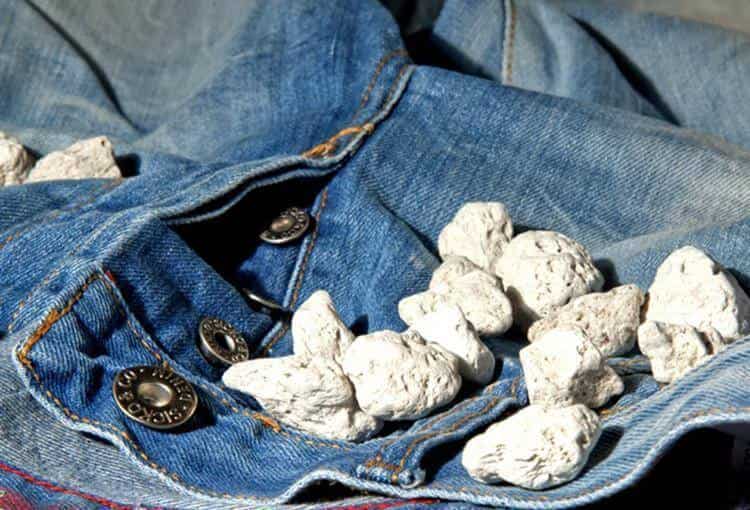Our Definitive Guide: What Are Stone Washed Jeans?
Stone-washed jeans have captivated fashion enthusiasts for years, blending a worn-in look with vintage charm. These iconic jeans stand out thanks to a unique washing process that gives them a distinctive character. In this blog post, I will explore the secrets behind stone-washed jeans, their origins, the specialized washing technique, and their enduring popularity.
Also Read: How to Style Stone Washed Jeans?
What Are Stone Washed Jeans?
Stone-washed jeans are denim pants that have undergone a particular washing process to achieve a faded and worn-out appearance. The term “stone washed” refers to the method used to create this look, which involves tumbling the jeans with pumice stones or abrasive materials during the washing process.

The process of stone-washing jeans typically begins with new, unwashed denim fabric. The fabric is cut, sewn into jeans, and loaded into large industrial washing machines. Pumice stones or other abrasive materials, water, and detergent are added to the wash.
As the washing machine agitates, the stones rub against the jeans, creating friction and abrasion. This process causes the indigo dye to fade and the fabric to soften, resulting in a worn-in appearance. The stones also create a slightly uneven and textured surface, giving the jeans a distressed look.
After the stone washing process, the jeans are rinsed to remove any remaining stones and then dried. Some manufacturers may use chemical treatments or other procedures to enhance the desired worn-out effect.
Why are they called stone washed jeans?
Stone-washed jeans get their name from the process used to create the worn and faded look on the denim. The name “stone washed” comes from the use of pumice stones in a commercial washing machine to create the distressed appearance of the fabric.

Stone washing is still a popular technique used in the denim industry. It has become an iconic feature of casual wear and represents a more relaxed and laid-back fashion style. Although there are other ways to achieve the distressed look of stone-washed jeans, such as sandblasting or acid washing, the method using pumice stones remains the most popular.
The History of Stone-Washing Jeans
Stone-washed jeans, an iconic style in the fashion industry, have a captivating history. In the 1970s, François Girbaud and Michael Hutchence stumbled upon the technique while washing jeans with pumice stones. This resulted in a distressed, faded look that became highly desirable. The industrialization of stone washing followed in the 1980s, propelling the trend to great heights.

The popularity of stone-washed jeans was fueled by their casual, “lived-in” appearance, and they became a symbol of rebellion and counterculture. Despite sustainability concerns, this fashion staple captivates and influences denim enthusiasts.
Pros and Cons of Stone Washed Jeans
Advantages of Stone Washed Jeans:
Vintage Appeal: Stone-washed jeans exude a distinctive vintage charm that is hard to replicate with other finishing techniques.
Comfort: The stone-washing process helps to soften the denim fabric, making the jeans more comfortable to wear right from the start.
Versatility: Stone-washed jeans can be effortlessly styled for casual and semi-formal occasions, offering various outfit possibilities.
Potential Drawbacks and Limitations:
Environmental Impact: The traditional industrial stone-washing process consumes significant water and energy, which can hurt the environment.
Fabric Wear and Tear: Repeated stone washing can lead to fabric erosion and weaken the overall durability of the jeans over time.
Limited Variation: While stone washing creates a unique faded appearance, the technique may restrict the range of color variations compared to other distressing methods.
Stone Washed Jeans in Fashion History
The 1980s witnessed the widespread popularity of stone-washed jeans as a symbol of casual coolness and rebellion. The distressed look became associated with the emerging youth culture and was embraced by fashion icons, musicians, and celebrities.

Stone-washed jeans transcended fashion and became a cultural phenomenon, representing a carefree and independent spirit. The distressed denim trend symbolized breaking traditional fashion norms and a desire for individuality.
Fashion is cyclical, and stone-washed jeans have recently experienced a remarkable revival. As vintage and retro styles regain popularity, designers and brands have reintroduced stone-washed denim into their collections, appealing to nostalgia seekers and fashion-forward individuals.
Distressed Denim: Stone Washed vs. Other Techniques
While stone washing is one technique used to distress denim, it is worth noting that there are other methods as well. Techniques like sandblasting, enzyme washing, and acid washing achieve different levels of distress and fading, each offering its unique aesthetic. The choice of distressing technique depends on the desired outcome and the designer’s vision.
Frequently Asked Questions (FAQs)
Are stone-washed jeans more expensive than regular jeans?
The cost of stone-washed jeans can vary depending on various factors, including the brand, quality, and design. The other stone-washing process may lead to a slightly higher price than regular jeans.
Can stone washing be done at home?
While stone washing can be done at home, it requires specialized equipment and materials. The industrial-scale stone washing machines used in the textile industry are challenging to replicate at home. Leaving the stone-washing process to professionals or exploring alternative home-based distressing techniques is recommended.
How do stone-washed jeans differ from acid-washed jeans?
Stone washing involves tumbling jeans with stones to create a faded and worn appearance, while acid washing uses chemicals to achieve a similar effect. Acid-washed jeans often have a more pronounced and uniform appearance, with distinct lighter areas, while stone-washed jeans tend to have a softer and more natural faded look.
Conclusion
Stone washed jeans have left an indelible mark on the fashion industry, embodying a sense of nostalgia and a contemporary style statement. Despite the environmental concerns associated with the traditional stone-washing process, the enduring appeal of distressed denim continues to captivate fashion enthusiasts worldwide. Whether it’s the vintage charm or the rebellious spirit they evoke, stone-washed jeans remain a timeless wardrobe essential, reflecting our ever-evolving fashion landscape.






